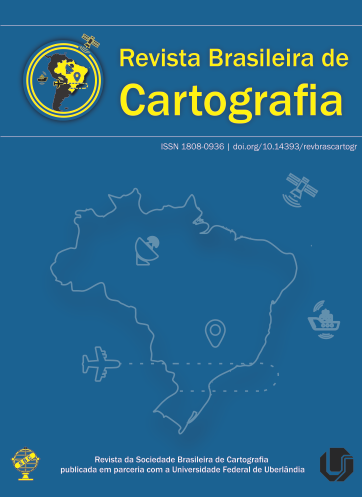Influence of the use of Primary, Secondary and Tertiary Series on the Definition of the Chart Datum and Local Mean Sea Level of Hydrographic Survey
Main Article Content
Abstract
Tide gouge can be divided into primary, secondary, and tertiary stations. The primary ones are operated for at least 19 years, the secondary ones between 1 and 19 years, and the tertiary ones between 32 days and 1 year. In this context, the present study aimed to analyze the influence of the historical series of sea levels in the definition of the Local Mean Sea Level (LMSL) and the Chart Datum (CD), using time-series of primary, secondary, and tertiary tide gouge, as well as to evaluate the discrepancies generated regarding their use. To achieve this purpose, a 39 years time-series of the Cananéia (SP) station was divided into two primary ones (each one of 19 years) and, from these, secondary and tertiary series were obtained. Then the LMSL, the harmonic components and, later, the CD of each time series were found. The evaluation was carried out through an exploratory analysis of the data discrepancies, and the results demonstrate that both LMSL and CD presents temporal variations and that they can be calculated based on tertiary series. However, it is recommended that these be obtained, always, based on current series.
Downloads
Metrics
Article Details

This work is licensed under a Creative Commons Attribution 3.0 Unported License.
Authors who publish in this journal agree to the following terms:
- Authors retain copyright and grant the journal right of first publication with the work simultaneously licensed under a Creative Commons Attribution License that allows others to share the work with an acknowledgment of the work's authorship and initial publication in this journal.
- Authors can enter into separate, additional contractual arrangements for the non-exclusive distribution of the journal's published version of the work (e.g., post it to an institutional repository or publish it in a book), with an acknowledgment of its initial publication in this journal.
- Authors are permitted and encouraged to post their work online (e.g., in institutional repositories or on their website) before and during the submission process, as it can lead to productive exchanges, as well as earlier and greater citation of published work (see "The Effect of Open Access").
References
ALBARICI, F. L.; GUIMARÃES, G. N.; TRABANCO, J. L. A. Análise relativa do nível médio do mar em Cananeia/SP. Revista Brasileira de Geomática, Curitiba, v. 6, n. 3, p. 176-193,2018. Disponível em: <https://periodicos.utfpr.edu.br/rbgeo>. Acesso em: abril de 2021.
ANTUNES, N. S. M. The Importance of the Tidal Datum in the Definition of Maritime Limits and Boundaries. BRADLEY, R.; SCHOFIELD, C. (Ed.). Maritime Briefing, International Boundaries Research Unit: University of Durham, v. 2, n.7, 38p., 2000. ISBN 1-897643-38-1.
ARENTZ, M. F. R. A modelagem hidrodinâmica como auxílio à navegação no canal norte do estuário do Amazonas. 182 f. Dissertação (Mestrado em Engenharia Oceânica). Universidade Federal do Rio de Janeiro. Rio de Janeiro, 2009.
BALAY, M. A. La cote du plan. Revue Hydrographic Internationale. v. 24, n. 2, pp. 109. 1952.
CENTRO DE HIDROGRAFIA DA MARINHA (CHM). Cartas Náuticas. Marinha do Brasil. Brasil. 2019. Disponível em: <https://www.marinha.mil.br/chm/chm/dados-do-segnav-cartas-nauticas/cartas-nauticas>. Acessor em: março de 2021.
COSTA, D. S. Variação do nível médio do mar-técnicas para a avaliação. 101 p. Dissertação (Mestrado em Engenharia e Transportes). Universidade de São Paulo, 2007.
COURTIER, A. Marées. Service Hydrographique de la Marine. 234 p. 1938.
Diretoria de Hidrografia e Navegação (DHN). NORMAM 25: Normas da Autoridade Marítima para Levantamentos Hidrográficos (2° revisão). Marinha do Brasil, Brasil, 2017. 94p.
FRANCO, A. S. Marés: Fundamentos, Análise e Previsão. 2º edição. Niterói. DHN, 2009.
FRANCO, A.S. Tides: fundamentais, analysis and prediction. 23° edição. São Paulo. Instituto de Pesquisas Tecnológicas, 1988.
INSTITUTO BRASILEIRO DE GEOGRAFIA E ESTATÍSTICA (IBGE). Esclarecimento sobre a relação entre o Datum Vertical do SGB (Imbituba e Santana) e os Níveis de Redução e “Zeros” Hidrográficos no Litoral Brasileiro. 2009. Disponível em: <ftp://geoftp.ibge.gov.br/metodos_e_outros_documentos_de_referencia/outros_documentos_tecnicos/rmpg/relacao_dvsgb_nr_zh.pdf>. Acesso em: abril de 2021.
INTERNATIONAL HYDROGRAPHIC ORGANIZATION (IHO). C-13: IHO Manual on Hydrography. Mônaco: International Hydrographic Bureau, 540p., 2005.
MIGUENS, A. P. Navegação: a Ciência e a Arte. Volume I - Navegação costeira, estimada e em águas restritas. Rio de Janeiro: DHN, Brasil, 1996. 538p.
PICKERING, M. D.; WELLS, N.C.; HORSBURGH, K.J.; GREEN, J.A.M. The impact of future sea-level rise on the European Shelf tides. Continental Shelf Research, v. 35, p. 1–15, 2012. DOI: 10.1016/j.csr.2011.11.011.
RAMOS, A. M. Aplicação, investigação e análise da metodologia de reduções batimétricas através do método GPS diferencial preciso. 221 f. Dissertação (Mestrado em Ciências Geodésicas) - Setor de Ciências da Terra, Universidade Federal do Paraná, Curitiba, 2007.
SANTANA, T. A.; DALAZOANA, R.. Integração dos Referenciais Verticais Terrestre e Oceânico: conceitos relacionados, projetos desenvolvidos e desafios. Revista Brasileira de Cartografia, Uberlândia, v. 72, n. 2, p. 345-364, 2020. DOI.: 10.14393/rbcv72n2-52611.
SILVA, F. M. P. Morfodinâmica da barra norte do Rio Amazonas sob a ótica da segurança da navegação. 140 f. Dissertação (Mestrado em Engenharia Oceânica) – Universidade Federal do Rio de Janeiro, Rio de Janeiro, 2013.
TEIXEIRA, G. L. G.; MAZZUCO, D. P.; DONIN JÚNIOR, D. J.; SANTANADA, F. R.; TECCHIO, R.; DAHER, V. B. Influência dos diferentes comprimentos de séries temporais na análise harmônica da maré astronômica na baía de Sepetiba – Rio de Janeiro, Brasil. Anais hidrográficos / Diretoria de hidrografia e Navegação. pp. 104 - 112. 2016.
WHITE, J. Tides: The Science and Spirit of the Ocean. Trinity University Press. p. 360, 2017.





